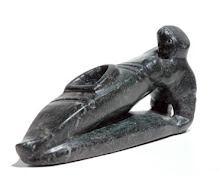
With their fast, and tippy looks, the kayaks of the Caribou Inuit have attracted my attention since I first knew of them. No doubt, the slender end horns at bow and stern are largely to blame. They contribute to the image of a long, narrow, graceful boat and, initially at least, also add a slightly eccentric air to it. Their function was not immediately apparent to me and they seemed almost some sort of ornament, an oddity in craft with such an utilitarian reputation as traditional Arctic kayaks.
 However, according to the studies of Eugene Arima, the horns are actually quite useful and serve a number of functions. Most seem related to the lack of stability of narrow kayaks with rounded hulls. For instance, the horns allow an assistant to steady the thin and nervous craft when departing or returning. The stern horn of a kayak coming to the rescue after a capsize provides in its base a place to hang on for the victim and the one of the upturned kayak can be (after righting the boat) tucked under the rescuer's arm allowing him to tow it. The base of the horns also provide anchor points for the poles used to join two or more kayaks in a raft to face rough seas or to carry goods with such narrow boats. I wonder if the horns of McKenzie Delta kayaks, which share some characteristics with Caribou kayaks, are mere coincidence. From the end of the bow horn, two red, spoon-shaped ornaments could be hung to swing merrily as kuviahunnihautik ("for the joy").
However, according to the studies of Eugene Arima, the horns are actually quite useful and serve a number of functions. Most seem related to the lack of stability of narrow kayaks with rounded hulls. For instance, the horns allow an assistant to steady the thin and nervous craft when departing or returning. The stern horn of a kayak coming to the rescue after a capsize provides in its base a place to hang on for the victim and the one of the upturned kayak can be (after righting the boat) tucked under the rescuer's arm allowing him to tow it. The base of the horns also provide anchor points for the poles used to join two or more kayaks in a raft to face rough seas or to carry goods with such narrow boats. I wonder if the horns of McKenzie Delta kayaks, which share some characteristics with Caribou kayaks, are mere coincidence. From the end of the bow horn, two red, spoon-shaped ornaments could be hung to swing merrily as kuviahunnihautik ("for the joy").
I like this last function. It indicates that paddling just for the pleasure of it was known and recognized by the traditional users of these kayaks and had its place among the dominant, more practical uses. For some reason, I enjoy thinking that not only gear and techniques trace its ancestry to Arctic kayaking traditions, but also what I consider the ethos of sea kayaking as we practice it today.
If you think a bit about it, it was to be expected.



No hay comentarios:
Publicar un comentario